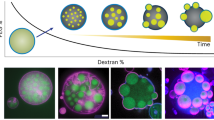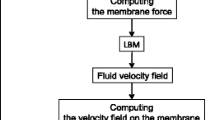Abstract
We present a phase field model for vesicle growth or shrinkage induced by an osmotic pressure due to a chemical potential gradient. The model consists of an Allen–Cahn equation describing the evolution of the phase field parameter that describes the shape of the vesicle and a Cahn–Hilliard-type equation describing the evolution of the ionic fluid. We establish conditions for vesicle growth or shrinkage via a common tangent construction using free energy curves. During the membrane deformation, the model ensures total mass conservation of the ionic fluid, and we weakly enforce a surface area constraint of the vesicle. We develop a stable numerical scheme and an efficient nonlinear multigrid solver to evolve the phase and concentration fields, and we use this to evolve the fields to near equilibrium for 2D vesicles. Convergence tests confirm an \({\mathcal {O}}(t+h^2)\) accuracy for our scheme and near-optimal convergence for our multigrid solver. Numerical results reveal that the diffuse interface model captures the main features of cell shape dynamics: for a growing vesicle, there exist circle-like equilibrium shapes if the concentration difference across the membrane and the initial osmotic pressure are large enough; while for a shrinking vesicle, there exists a rich collection of finger-like equilibrium morphologies.












Similar content being viewed by others
References
Alberts B, Heald R, Johnson A, Morgan D, Raff M, Roberts K, Walter P (2022) Molecular biology of the cell, 7th edn. W. W. Norton and Company, New York
Bartels S (2015) The Allen–Cahn equation. In: Numerical methods for nonlinear partial differential equations, vol 47. Springer, Cham, pp 153–182. https://doi.org/10.1007/978-3-319-13797-16
Baumgarten CM, Feher JJ (2012) Chapter 16—Osmosis and regulation of cell volume. In: Sperelakis N (ed) Cell physiology source book, 4th ed. Academic Press, San Diego, pp 261–301. https://doi.org/10.1016/B978-0-12-387738-3.00016-0
Cahn JW, Hilliard JE (1958) Free energy of a nonuniform system. I. Interfacial free energy. J Chem Phys 28:258–267. https://doi.org/10.1063/1.1744102
Chen R, Ji G, Yang X, Zhang H (2015) Decoupled energy stable schemes for phase-field vesicle membrane model. J Comput Phys 302:509–523. https://doi.org/10.1016/j.jcp.2015.09.025
Cheng K, Feng W, Wang C, Wise SM (2019) An energy stable fourth order finite difference scheme for the Cahn–Hilliard equation. J Comput Appl Math 362:574–595. https://doi.org/10.1016/j.cam.2018.05.039
Du Q, Liu C, Wang X (2004) A phase field approach in the numerical study of the elastic bending energy for vesicle membranes. J Comput Phys 198:450–468. https://doi.org/10.1016/j.jcp.2004.01.029
Du Q, Liu C, Ryham R, Wang X (2005) A phase field formulation of the Willmore problem. Nonlinearity 18:1249–1267. https://doi.org/10.1088/0951-7715/18/3/016
Elani Y, Law RV, Ces O (2014) Vesicle-based artificial cells as chemical microreactors with spatially segregated reaction pathways. Nat Commun 5:5305. https://doi.org/10.1038/ncomms6305
Feng W, Guan Z, Lowengrub J, Wang C, Wise S, Chen Y (2018) A uniquely solvable, energy stable numerical scheme for the functionalized Cahn–Hilliard equation and its convergence analysis. J Sci Comput 76:1938–1967. https://doi.org/10.1007/s10915-018-0690-1
Gera P, Salac D (2018) Three-dimensional multicomponent vesicles: dynamics and influence of material properties. Soft Matter 14:7690–7705. https://doi.org/10.1039/C8SM01087K
Gera P, Salac D, Spagnolie SE (2022) Swinging and tumbling of multicomponent vesicles in flow. J Fluid Mech 935:A39. https://doi.org/10.1017/jfm.2022.40
Giga M-H, Kirshtein A, Liu C (2017) Variational modeling and complex fluids. In: Giga Y, Novotny A (eds) Handbook of mathematical analysis in mechanics of viscous fluids. Springer, Cham, p 141. https://doi.org/10.1007/978-3-319-10151-42-1
Gu R, Wang X, Gunzburger MD (2016) A two phase field model for tracking vesicle–vesicle adhesion. J Math Biol 73:1293–1319. https://doi.org/10.1007/s00285-016-0994-4
Guo J, Wang C, Wise SM, Yue X (2016) An H2 convergence of a second-order convex-splitting, finite difference scheme for the three-dimensional Cahn–Hilliard equation. Commun Math Sci 14:66. https://doi.org/10.4310/CMS.2016.v14.n2.a8
Guo M et al (2017) Cell volume change through water efflux impacts cell stiffness and stem cell fate. PNAS 114:E8618–E8627. https://doi.org/10.1073/pnas.1705179114
Guo J, Wang C, Wise SM, Yue X (2021) An improved error analysis for a second-order numerical scheme for the Cahn–Hilliard equation. J Comput Appl Math 388:113–300. https://doi.org/10.1016/j.cam.2020.113300
Haußer F, Marth W, Li S, Lowengrub J, Rätz A, Voigt A (2013) Thermodynamically consistent models for two-component vesicles. Int J Biomath Biostat 2:1948
Henson VE (2003) Multigrid methods nonlinear problems: an overview. In: Bouman CA, Stevenson RL (eds) Computational imaging, vol 5016. SPIE, p 3648. https://doi.org/10.1117/12.499473
Hoffmann EK, Lambert IH, Pedersen SF (2009) Physiology of cell volume regulation in vertebrates. Physiol Rev 89:193–277. https://doi.org/10.1152/physrev.00037.2007
Hu Z, Wise S, Wang C, Lowengrub J (2009) Stable and efficient finite-difference nonlinear-multigrid schemes for the phase-field crystal equation. J Comput Phys 228:5323–5339. https://doi.org/10.1016/j.jcp.2009.04.020
Jayathilake P G, Khoo B, Tan Z (2010a) Effect of membrane permeability on capsule substrate adhesion: computation using immersed interface method. Chem Eng Sci 65:3567–3578. https://doi.org/10.1016/j.ces.2010.02.050
Jayathilake PG, Tan Z, Khoo B, Wijeysundera N (2010b) Deformation and osmotic swelling of an elastic membrane capsule in Stokes flows by the immersed interface method. Chem Eng Sci 65:1237–1252. https://doi.org/10.1016/j.ces.2009.09.078
Kay D, Welford R (2006) A multigrid finite element solver for the Cahn–Hilliard equation. J Comput Phys 212:288–304. https://doi.org/10.1016/j.jcp.2005.07.004
Kobayashi R (2010) A brief introduction to phase field method. AIP Conf Proc 1270:282–291. https://doi.org/10.1063/1.3476232
LadyofHats (2007) Tonicity Wikipedia, The Free Encyclopedia. https://en.wikipedia.org/wiki/File:Osmoticpressureonbloodcellsdiagram.svg. Accessed 11 Sept 2020
Layton AT (2006) Modeling water transport across elastic boundaries using an explicit jump method. SISC 28:2189–2207. https://doi.org/10.1137/050642198
Lee D, Huh J-Y, Jeong D, Shin J, Yun A, Kim J (2014) Physical, mathematical, and numerical derivations of the Cahn–Hilliard equation. Comput Mater Sci 81:216–225. https://doi.org/10.1016/j.commatsci.2013.08.027
Li S, Lowengrub J, Voigt A (2012) Locomotion, wrinkling, and budding of a multicomponent vesicle in viscous fluids. Comm Math Sci 10:645–670. https://doi.org/10.4310/CMS.2012.v10.n2.a11
Liu K, Li S (2014) Nonlinear simulations of vesicle wrinkling. Math Methods Appl Sci 37:1093–1112. https://doi.org/10.1002/mma.2867
Liu K, Hamilton C, Allard J, Lowengrub J, Li S (2016) Wrinkling dynamics of fluctuating vesicles in time dependent viscous flow. Soft Matter 12:5663–5675. https://doi.org/10.1039/C6SM00499G
Liu K, Marple GR, Allard J, Li S, Veerapaneni S, Lowengrub J (2017) Dynamics of a multicomponent vesicle in shear flow. Soft Matter 13:3521–3531. https://doi.org/10.1039/C6SM02452A
Lowengrub J, Rätz A, Voigt A (2009) Phase-field modeling of the dynamics of multicomponent vesicles: spinodal decomposition, coarsening, budding, and fission. Phys Rev E Stat Nonlinear Soft Matter Phys 79: 031926. https://doi.org/10.1103/PhysRevE.79.031926
Mori Y, Liu C, Eisenberg R (2011) A model of electrodiffusion and osmotic water flow and its energetic structure. Phys D Nonlinear Phenom 240:1835–1852. https://doi.org/10.1016/j.physd.2011.08.010
Pelton AD (2019) Phase diagrams and thermodynamic modeling of solutions. Elsevier, Amsterdam. https://doi.org/10.1016/C2013-0-19504-9
Peskin CS (1977) Numerical analysis of blood flow in the heart. J Comput Phys 25:220–252. https://doi.org/10.1016/0021-9991(77)90100-0
Provatas N, Elder K (2010) Phase-field methods in materials science and engineering. Wiley, New York. https://doi.org/10.1002/9783527631520
Quaife B, Gannon A, Young Y-N (2021) Hydrodynamics of a semipermeable inextensible membrane under flow and confinement. Phys Rev Fluids 6:073601. https://doi.org/10.1103/PhysRevFluids.6.073601
Salac D, Miksis M (2011) A level set projection model of lipid vesicles in general flows. J Comput Phys 230:8192–8215. https://doi.org/10.1016/j.jcp.2011.07.019
Shen J, Yang X, Wang Q (2012) Mass and volume conservation in phase field models for binary fluids. Commun Comput Phys 13:1045–1065. https://doi.org/10.4208/cicp.300711.160212a
Shen J, Xu J, Yang J (2018) The scalar auxiliary variable (SAV) approach for gradient flows. J Comput Phys 353:407–416. https://doi.org/10.1016/j.jcp.2017.10.021
Sohn JS, Tseng Y-H, Li S, Voigt A, Lowengrub JS (2010) Dynamics of multicomponent vesicles in a viscous fluid. J Comput Phys 229:119–144. https://doi.org/10.1016/j.jcp.2009.09.017
Sohn J, Li S, Li X, Lowengrub J (2012) Dynamics of multicomponent vesicles in a viscous fluid. Int J Numer Methods Biomed Eng 28:346–368. https://doi.org/10.1002/cnm.2475
Strange K (2004) Cellular volume homeostasis. Adv Physiol Educ 28:155–159. https://doi.org/10.1152/advan.00034.2004
Trottenberg U, Oosterlee CW, Schüller A (2001) Multigrid. Academic Press, San Diego
Veerapaneni SK, Gueyffier D, Biros G, Zorin D (2009) A numerical method for simulating the dynamics of 3D axisymmetric vesicles suspended in viscous flows. J Comput Phys 228:7233–7249. https://doi.org/10.1016/j.jcp.2009.06.020
Veerapaneni SK, Gueyffier D, Zorin D, Biros G (2009) A boundary integral method for simulating the dynamics of inextensible vesicles suspended in a viscous fluid in 2D. J Comput Phys 228:2334–2353. https://doi.org/10.1016/j.jcp.2008.11.036
Vogl CJ, Miksis MJ, Davis SH, Salac D (2014) The effect of glass-forming sugars on vesicle morphology and water distribution during drying. J R Soc Interface 11:66. https://doi.org/10.1098/rsif.2014.0646
Wang X, Du Q (2008) Modelling and simulations of multi-component lipid membranes and open membranes via diffuse interface approaches. J Math Biol 56:34771. https://doi.org/10.1007/s00285-007-0118-2
Wang X, Gong X, Sugiyama K, Takagi S, Huang H (2020) An immersed boundary method for mass transfer through porous biomembranes under large deformations. J Comput Phys 413:109–444. https://doi.org/10.1016/j.jcp.2020.109444
Wise SM (2010) Unconditionally stable finite difference, nonlinear multigrid simulation of the Cahn–Hilliard–Hele–Shaw system of equations. J Sci Comput 44:3668. https://doi.org/10.1007/s10915-010-9363-4
Yan Y, Chen W, Wang C, Wise SM (2018) A second-order energy stable BDF numerical scheme for the Cahn–Hilliard equation. Commun Comput Phys 23:572–602. https://doi.org/10.4208/cicp.OA-2016-0197
Yang X (2021) Numerical approximations of the Navier–Stokes equation coupled with volume-conserved multi-phase-field vesicles system: fully-decoupled, linear, unconditionally energy stable and second-order time-accurate numerical scheme. Comput Methods Appl Mech Eng 375:113600. https://doi.org/10.1016/j.cma.2020.113600
Yao L, Mori Y (2017) A numerical method for osmotic water flow and solute diffusion with deformable membrane boundaries in two spatial dimension. J Comput Phys 350:728–746. https://doi.org/10.1016/j.jcp.2017.09.006
Acknowledgements
SL acknowledges the support from the National Science Foundation (NSF), Division of Mathematical Sciences Grant DMS-1720420. SL was also partially supported by Grant ECCS-1307625. SMW acknowledges support from NSF Grant, DMS 2012634. JL acknowledges partial support from the NSF through Grants DMS-1714973, DMS-1719960, and DMS-1763272 and the Simons Foundation (594598QN) for a NSF-Simons Center for Multiscale Cell Fate Research. JL also thanks the National Institutes of Health for partial support through grants 1U54CA217378-01A1 for a National Center in Cancer Systems Biology at UC Irvine and P30CA062203 for the Chao Family Comprehensive Cancer Center at UC Irvine.
Author information
Authors and Affiliations
Corresponding author
Ethics declarations
Conflict of interest
The authors declare that we have no known conflicts of interest regarding the submission of this manuscript.
Additional information
Publisher's Note
Springer Nature remains neutral with regard to jurisdictional claims in published maps and institutional affiliations.
Rights and permissions
Springer Nature or its licensor (e.g. a society or other partner) holds exclusive rights to this article under a publishing agreement with the author(s) or other rightsholder(s); author self-archiving of the accepted manuscript version of this article is solely governed by the terms of such publishing agreement and applicable law.
About this article
Cite this article
Tang, X., Li, S., Lowengrub, J.S. et al. Phase field modeling and computation of vesicle growth or shrinkage. J. Math. Biol. 86, 97 (2023). https://doi.org/10.1007/s00285-023-01928-2
Received:
Revised:
Accepted:
Published:
DOI: https://doi.org/10.1007/s00285-023-01928-2
Keywords
- Allen–Cahn equation
- Cahn–Hilliard equation
- Osmosis
- Vesicle growth or shrinkage
- Nonlinear multigrid
- Convergence




